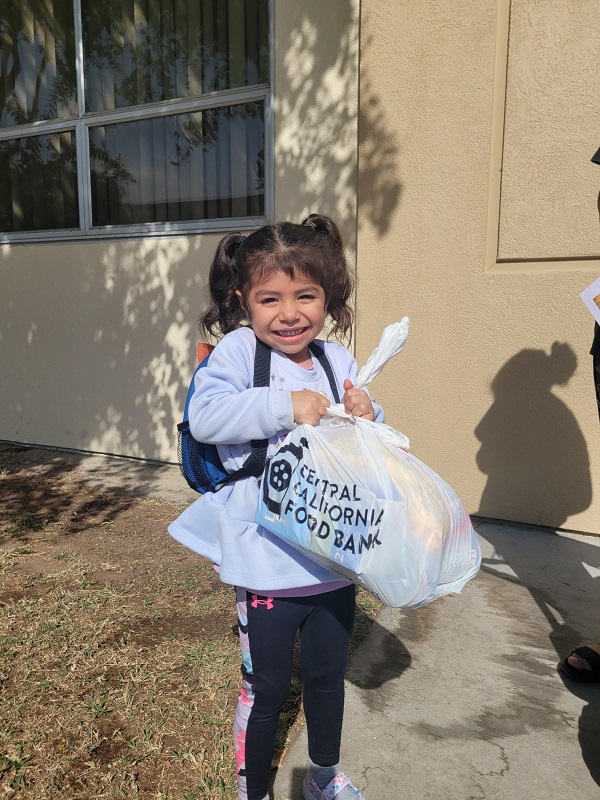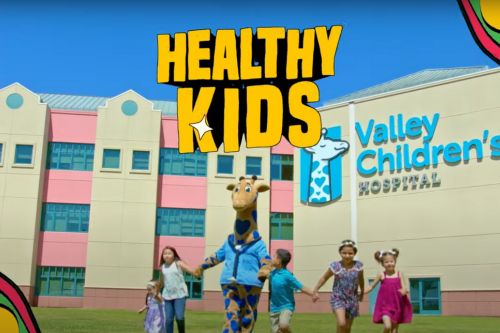
The State Of Our Children 360: March 2024
In this month's edition, get an in-depth look and perspectives from subject matter experts about why access to healthy foods supports children's physical, mental and emotional well-being.
Articles in this issue:
Food, Childhood Trauma and Healing: Is There a Connection?
 A 12-year-old girl named Maya lived in a small rural town between dry, golden rolling hills and acres of farmland in California's Central Valley. Maya's parents worked hard six days a week and could barely make ends meet, often leaving little on the table for Maya and her two younger siblings. Maya often went to bed hungry, knowing the next meal would be breakfast at school if it was a school day.
A 12-year-old girl named Maya lived in a small rural town between dry, golden rolling hills and acres of farmland in California's Central Valley. Maya's parents worked hard six days a week and could barely make ends meet, often leaving little on the table for Maya and her two younger siblings. Maya often went to bed hungry, knowing the next meal would be breakfast at school if it was a school day.
In addition to facing hunger, Maya bore the scars of childhood trauma. She consistently witnessed her parents arguing loudly, sometimes turning violent, creating a constant atmosphere of fear and stress in their home. As the oldest, Maya’s siblings often looked to her for comfort and security. These experiences left Maya anxious, scared and insecure as she grew older.
Despite the challenges she faced, Maya found solace in books and developed a passion for cooking and experimenting with affordable ingredients to hone her skills in the kitchen.
One day, Maya’s high school counselor noticed her quiet struggles and introduced her to a local community organization that provided support for individuals experiencing food insecurity and trauma. A community health worker (CHW) met with Maya and her parents and connected them to various resources. Maya received counseling and group therapy, where she began to confront her childhood traumas and learn healthy coping mechanisms. The CHW also connected Maya to a food program where she worked and received daily food for her family.
As Maya delved deeper into the healing process, she discovered the power of sharing her story with others who had gone through similar challenges. She began volunteering at the community organization, teaching cooking classes and leading support groups for children going through tough times.
With time, Maya’s passion for cooking and helping others became her main motivation. She started a small catering business specializing in nutritious meals for families in need.
As Maya continued to heal and grow, she realized that her past struggles had shaped her into a strong, empathetic individual. She embraced her journey, knowing that her experiences of food insecurity and childhood trauma had given her a unique perspective and a deep well of compassion to draw from.
Maya’s story is a testament to the power of resilience, healing and the transformative nature of helping others in need. In her journey from a place of anxiety and fear to one of purpose and hope, Maya found strength and a profound connection to the healing power of food and community.
While this story is of a fictional character inspired by real experiences, many adults and children can relate to Maya, growing up hungry and in an unstable and violent environment. Maya was fortunate to have caring, supportive adults outside of her home who provided Maya and her family with pathways to healing.
Maya experienced what professionals call adverse childhood experiences, also known as ACEs. ACEs are traumatic events that occur during childhood, such as abuse, neglect or household dysfunction. Research has shown that individuals who have experienced ACEs are at risk of developing chronic health conditions, mental health disorders and economic hardship, all of which can contribute to food insecurity.
According to a study by the Centers for Disease Control and Prevention (CDC), individuals with a higher number of ACEs are more likely to have lower household incomes and struggle with accessing an adequate and consistent food supply. This highlights the interconnected nature of childhood trauma, socioeconomic circumstances and food insecurity.
Furthermore, ACEs can also impact a person’s relationship with food and their ability to make healthy food choices. People who have experienced trauma in childhood may use food as a coping mechanism, leading to unhealthy eating habits and a higher risk of nutrition-related health problems.
Overall, the link between ACEs and food insecurity underscores the importance of addressing childhood trauma and providing support to individuals and families to reduce the long-term impacts of adverse experiences on health and well-being.
To explore the connection between ACEs and food insecurity, participate in one of the Fresno Community Health Improvement Partnership’s (FCHIP’s) training sessions, Serving Food and Healing Trauma. This training is especially for anyone who works in a food program for underserved children and families and has value for anyone interested in the topic. If you know of someone who is experiencing hardships, are in need of medical mental health or social service resources, contact the Fresno HOPE Pathways Community Program.
About the Author
Sue Kincaid, M.S., is the director of Fresno Community Health Improvement Partnership (FCHIP). FCHIP is an anchoring multi-sector health network that works closely with the community, multi-sector partners, and local coalitions FCHIP's partners collaborate to align work and leverage resources to improve health and well-being for all in the Fresno region. FCHIP's collaborative platform provides the means to develop a comprehensive whole-person approach to complex and interrelated health problems and to engage partners across sectors to address gaps and barriers that lead to racial inequities in health. Good health and well-being are essential for children to reach their full potential, for the workforce to be productive, and for the future prosperity of our region.
The Role of Food in Health
 Being healthy, we sometimes take for granted. How our food intake affects our health is very important, but not always front and center in our minds on a day-to-day basis. Our goals with food usually include enjoying what we eat, satisfying hunger and, if we are lucky, spending time with loved ones during our meal. Children have multiple influences in their lives that affect what they eat and, as they grow up, make their own choices. The best choices occur when children are offered a variety of fruits, vegetables and grains. When teaching children to eat in variety, it is best for the whole family to participate, especially when dietary changes are necessary regarding disease processes.
Being healthy, we sometimes take for granted. How our food intake affects our health is very important, but not always front and center in our minds on a day-to-day basis. Our goals with food usually include enjoying what we eat, satisfying hunger and, if we are lucky, spending time with loved ones during our meal. Children have multiple influences in their lives that affect what they eat and, as they grow up, make their own choices. The best choices occur when children are offered a variety of fruits, vegetables and grains. When teaching children to eat in variety, it is best for the whole family to participate, especially when dietary changes are necessary regarding disease processes.
Healthy Diets for Gastrointestinal (GI) Illnesses in Children
There are many gastrointestinal illnesses affected by the food children eat, and choosing the healthiest food can improve the outcome of their disease. For example, obese children have baseline risks such as fatty liver which injures the liver and affects which medications they can take. With fatty liver, an ordinary virus can cause liver failure.
Inflammatory bowel disease is a gastrointestinal disorder in children that affects the intestinal lining, causing ulcers and sometimes strictures or abscesses in the abdomen. Children are usually very ill and often malnourished. Given that the disease targets our source of nutrient digestion and absorption, research has shown that nutrition choices are vital to inducing and maintaining remission. Remission is described as the state of healing where the tissue is normal and the child feels well, leading a normal lifestyle and not having daily pain. Some of the most successful diets have been plant-based, gluten-free, low carbohydrate and simple sugar and sometimes, dairy-free. Dietary changes alone can help prevent escalation of medical and/or surgical treatments.
Gastric ulcers and gastroesophageal reflux, unfortunately, do not just affect adults, but also children. Ulcers can cause pain, vomiting, weight loss and gastrointestinal bleeding and anemia. Gastroesophageal reflux can cause similar symptoms, including bleeding if it goes on very long. Sometimes these problems can be avoided or resolved by changing the diet. One of the best ways is to eliminate spicy chips, which have been known to cause severe ulcers and bleeding in some children. They do not offer any nutritional value, and the spicy powder on the chip causes direct contact damage to the lining of the gastrointestinal tissue. Even taking antacids may not prevent it. There are natural foods that can satisfy the need for spicy flavor, which is healthier in moderation.
Celiac disease is a condition that is triggered by a combination of a genetic predisposition, a virus, and gluten consumption. Gluten is a protein in the diet that is man-made and the human body is not naturally good at digesting it. It is included in many foods that have wheat flour, such as pasta, bread and tortillas. In addition, it is an additive in many pre-made foods and snacks. There are some people who have gluten sensitivity in which eating a gluten-free diet helps them feel better. But, with celiac disease, damage to the tissue lining occurs when an affected child eats gluten. This is a difficult diagnosis because it requires completely changing a diet since most people eat gluten daily. Even most cultures have gluten in their diets. There are multiple difficulties such as preventing cross-contamination in kitchens, eating at restaurants and getting proper nutrition at school. It is very expensive and planning ahead is imperative, especially for toddlers and young school-age children who may have picky eating habits. If they do not stay on the diet, their general health is at risk as it leads to very poor growth, anemia, vitamin D deficiency with bone mineral density problems and easy fracturing of the bone, to name a few. Older adults with untreated celiac disease are at risk of developing intestinal lymphoma.
How to Create Healthy Food Habits for Kids
Picky eating habits are common at all ages, but especially in toddlers and school-age children. Parents who are successful with teaching their children to eat a variety of foods, including fruits, vegetables, grains and fish, as well as avoid junk food, fast food and frequent snacking will be the most successful. Sometimes, our tendency as parents is to feed children more often if they are not good at finishing meals, but actually it is best to maintain mealtimes and let them get hungry for the next meal, even if they do not eat as much at one meal. Studies have shown that giving them lots of snacks and high sugar or high fat supplements as the child ages is associated with obesity. In addition, portion control is vital to minimizing obesity. In fact, conditions like gastroesophageal reflux and fatty liver are improved by eating smaller portions. For obese patients, in addition to exercise, smaller portions will improve changes of weight loss.
Two very common conditions for children that give them a lot of morbidity on a daily basis are constipation and functional abdominal pain, which is similar to irritable bowel syndrome in adults. For both conditions, the pain is real and causes kids to miss out on school and fun activities, and often creates worry about the next episode. However, these disorders are caused by a dysfunction of the GI system’s normal activity and there is nothing wrong with the GI tract at all. Eliminating junk food and fast food, while replacing it with 5–9 servings of fruits and vegetables per day, moderating the amount of dairy and gluten in the diet (i.e. minimizing pizza) could make a very big improvement or even prevent these problems if they are started early in life. I cannot emphasize enough the importance of incorporating a variety of vegetables in the diet. When eating pizza, for example, I recommend including vegetables such as a salad to minimize the amount of pizza eaten. Other improvements are made by drinking appropriate water every day instead of juice or soda and not rushing during meals.
If we think of food as medicine, it makes sense to incorporate healthy food to heal. Most parents will tell me that they will go far and wide, do anything and even pay anything for their child’s health. Sometimes, the best thing to do is to simply start with a healthy diet. The younger the child, the better, because changing dietary preferences is not easy as they get older. That is easier said than done if living in a locale with a food desert and with the significant cost of food. Especially, if one is trying to purchase high quality and/or organic foods, it can change the family’s entire budget. Even discussing with some families who do not have full kitchens, preventing cooking, or families where work interferes with mealtimes, the barriers can be immense. Some children are eating pre-packaged foods to satiate hunger, but it is not adding nutritional value; side effects of the ingredients could be making the children more ill without them even knowing it.
What can we do about children’s health?
Obesity has become an epidemic in America, which has created a severe decline in our health while creating an exponential impact on our healthcare system. In children, we are treating gallbladder disease and pancreatitis routinely, which was unusual decades ago. These are both very painful and highly risky diseases for children. From the grand scheme, that is very important. But, when I look at an individual child, I think of the preventative benefits from the age of 1 year old and educating families about options for healthy diets. We have social workers and medical systems to aid in treating the health deficits caused by obesity, but we do not have the support families need to intervene when it would be the least effort and the best benefit as children. Educating families and recruiting parents and children who have been successful could be one example to support parents of young children. Having dieticians in the schools to meet with parents would be another one and working with community groups to provide the tools parents may need to be able to cook and/or buy healthy foods would be wonderful for families in our community. Motivation can also be difficult once someone has already had the complications of obesity, because of the illnesses they experience. Prevention really does start young, and then they can find the joy in a healthy diet and feeling well.
About the Author
Board certified in pediatrics and pediatric gastroenterology, Dr. Karla Au Yeung joined Valley Children’s as a pediatric gastroenterologist in April 2016. Her areas of special interest in gastroenterology include pediatric aerodigestive problems, including gastroesophageal reflux disease affecting respiratory and feeding conditions in children, eosinophilic esophagitis, esophageal motility disorders, and congenital esophageal disorders such as esophageal atresia.
Food Security: A Collective Responsibility That Makes a Difference
 Food insecurity is a pressing issue in Central California, profoundly affecting the health and well-being of children in the region. Defined as the lack of consistent access to enough food for an active, healthy life, food insecurity disrupts physical, mental and emotional development, perpetuating a cycle of poverty and inequality. In Central California, where agriculture dominates the economy, paradoxically, many families struggle to put food on the table. According to Feeding America, approximately 1 in 4 children in the region face food insecurity, significantly higher than the national average. This staggering statistic underscores the urgent need for comprehensive interventions to address this crisis.
Food insecurity is a pressing issue in Central California, profoundly affecting the health and well-being of children in the region. Defined as the lack of consistent access to enough food for an active, healthy life, food insecurity disrupts physical, mental and emotional development, perpetuating a cycle of poverty and inequality. In Central California, where agriculture dominates the economy, paradoxically, many families struggle to put food on the table. According to Feeding America, approximately 1 in 4 children in the region face food insecurity, significantly higher than the national average. This staggering statistic underscores the urgent need for comprehensive interventions to address this crisis.
The repercussions of food insecurity on children's health are multifaceted and long-lasting. Malnutrition, a common consequence of inadequate food access, stunts growth, weakens immune systems and impairs cognitive function. Research published in the American Journal of Public Health highlights the correlation between food insecurity and increased risk of chronic illnesses such as asthma, diabetes and obesity among children in Central California.
Food insecurity also exacerbates mental health issues among children, leading to anxiety, depression and behavioral problems. A study conducted by the University of California, Davis, found that children from food-insecure households in Central California were more likely to experience emotional distress and exhibit aggressive behaviors compared to their food-secure counterparts. These psychological challenges can hinder academic performance and social integration, perpetuating the cycle of poverty.
Access to nutritious food is crucial for mitigating the adverse effects of food insecurity on children's health. However, Central California's communities of concentrated poverty and rural communities often lack adequate grocery stores and fresh produce markets, further worsening the problem. The phenomenon known as food deserts disproportionately affects low-income families, limiting their ability to make healthy dietary choices.
Central California Food Bank serves as a lifeline for more than 100,000 children each month, ensuring they have access to essential nourishment. With a team that works tirelessly to source nutritious food and build strategic partnerships with community centers, faith-based institutions and school sites, the food bank extends its reach into underserved areas, effectively reducing food insecurity among children in the region.
By establishing distribution points at community centers, the food bank brings food access directly to neighborhoods most in need. These centers serve as hubs of support, offering not only nutritious meals, but also connecting families with additional resources and services to address underlying issues contributing to food insecurity.
Partnering with nearly 150 faith-based institutions amplifies the food bank’s impact, leveraging existing networks and community trust to reach vulnerable populations. Places of worship become distribution sites, fostering a sense of solidarity and compassion within local communities while ensuring that children and their families receive the sustenance they need to thrive.
School sites play a crucial role in the fight against childhood hunger, as many children rely on school meals as their primary source of nutrition. By collaborating with almost 50 schools, the food bank helps bridge the gap during weekends and holidays when these meals may not be available. Through backpack programs and on-site pantries, students have access to nutritious food, empowering them to focus on learning and development without the distraction of hunger.
Central California Food Bank’s holistic approach to food distribution not only addresses immediate hunger needs and improves health outcomes of children, but it also cultivates long-term resilience within communities. By fostering partnerships and empowering local stakeholders, the food bank fosters a sense of ownership and collective responsibility in the fight against food insecurity.
About the Authors
Kym Dildine and Natalie Caples are co-chief executive officers of the Central California Food Bank.
Healthy Resources
|

Valley Children's has a YouTube playlist with videos in English and Spanish dedicated to helping families create healthy futures through nutrition and physical activity.
Visit our YouTube playlist
|
|

Let’s Eat Healthy offers FREE nutrition and education materials for the classroom, medical office and community that explore healthy, sustainable eating patterns.
Learn more
|